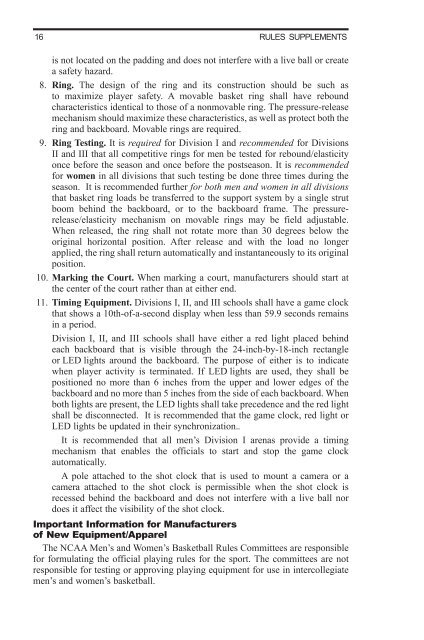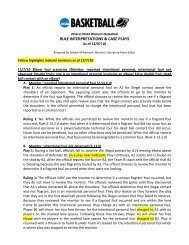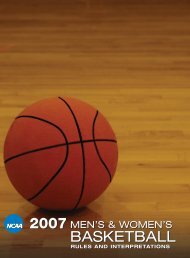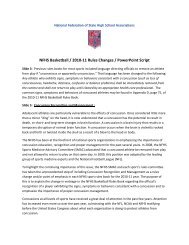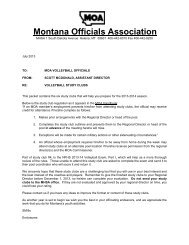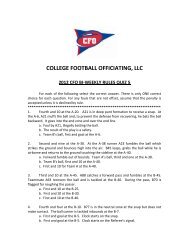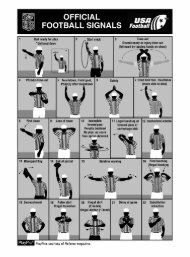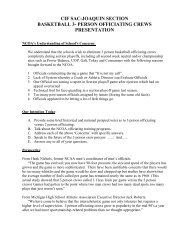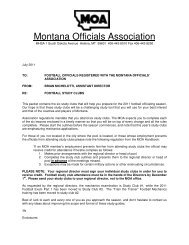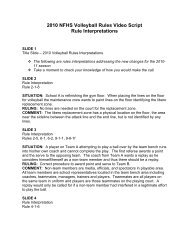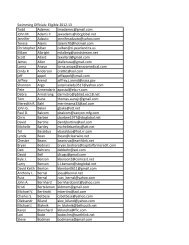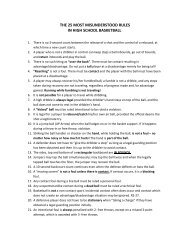2011-12 AND 2012-13 MEN'S AND WOMEN'S RULES - NAIA
2011-12 AND 2012-13 MEN'S AND WOMEN'S RULES - NAIA
2011-12 AND 2012-13 MEN'S AND WOMEN'S RULES - NAIA
You also want an ePaper? Increase the reach of your titles
YUMPU automatically turns print PDFs into web optimized ePapers that Google loves.
16 rULES Supplements<br />
is not located on the padding and does not interfere with a live ball or create<br />
a safety hazard.<br />
8. Ring. The design of the ring and its construction should be such as<br />
to maximize player safety. A movable basket ring shall have rebound<br />
characteristics identical to those of a nonmovable ring. The pressure-release<br />
mechanism should maximize these characteristics, as well as protect both the<br />
ring and backboard. Movable rings are required.<br />
9. Ring Testing. It is required for Division I and recommended for Divisions<br />
II and III that all competitive rings for men be tested for rebound/elasticity<br />
once before the season and once before the postseason. It is recommended<br />
for women in all divisions that such testing be done three times during the<br />
season. It is recommended further for both men and women in all divisions<br />
that basket ring loads be transferred to the support system by a single strut<br />
boom behind the backboard, or to the backboard frame. The pressurerelease/elasticity<br />
mechanism on movable rings may be field adjustable.<br />
When released, the ring shall not rotate more than 30 degrees below the<br />
original horizontal position. After release and with the load no longer<br />
applied, the ring shall return automatically and instantaneously to its original<br />
position.<br />
10. Marking the Court. When marking a court, manufacturers should start at<br />
the center of the court rather than at either end.<br />
11. Timing Equipment. Divisions I, II, and III schools shall have a game clock<br />
that shows a 10th-of-a-second display when less than 59.9 seconds remains<br />
in a period.<br />
Division I, II, and III schools shall have either a red light placed behind<br />
each backboard that is visible through the 24-inch-by-18-inch rectangle<br />
or LED lights around the backboard. The purpose of either is to indicate<br />
when player activity is terminated. If LED lights are used, they shall be<br />
positioned no more than 6 inches from the upper and lower edges of the<br />
backboard and no more than 5 inches from the side of each backboard. When<br />
both lights are present, the LED lights shall take precedence and the red light<br />
shall be disconnected. It is recommended that the game clock, red light or<br />
LED lights be updated in their synchronization..<br />
It is recommended that all men’s Division I arenas provide a timing<br />
mechanism that enables the officials to start and stop the game clock<br />
automatically.<br />
A pole attached to the shot clock that is used to mount a camera or a<br />
camera attached to the shot clock is permissible when the shot clock is<br />
recessed behind the backboard and does not interfere with a live ball nor<br />
does it affect the visibility of the shot clock.<br />
Important Information for Manufacturers<br />
of New Equipment/Apparel<br />
The NCAA Men’s and Women’s Basketball Rules Committees are responsible<br />
for formulating the official playing rules for the sport. The committees are not<br />
responsible for testing or approving playing equipment for use in intercollegiate<br />
men’s and women’s basketball.


